Iran puts access limit to its major nuclear plant in Natanz. Concerns over the security of the nuclear sites, following Israeli attacks in recent months, was the potential underlying reason.
The clashes with IAEA inspectors which has mainly focused on access limit, were has been the status quo of the past months. The move also heightened tensions with the Western powers who are at the same table with Iranian official for the revival of the nuclear deal.
It comes after a series of actions by Iran, including unauthorized uranium enrichment levels and putting access limit to inspectors from IAEA and the United Nations.
Iran’s policies, nevertheless, were taken in reaction to the unilateral withdrawal of United States from the deal. Imposing sanctions on Iranian economy and Europe’s ignoring conduct regarding Iran’s rights based on JCPOA infuriated Tehran. Imposing access limit to inspections was the first Iranian response to the massive violation of the agreement.
The western powers believe Iran’s access limit on inspection is a provoking step leading to further deterioration in negotiation process.
Any motives for Iran’s decision other than formal security considerations it stated as justifications are unknown. The country, by the way, has already had access issues with the IAEA. Tehran refused the IAEA access to facilities for quick inspections for two times last year.
The IAEA has refrained from informing its member nations about the situation or convening an emergency meeting. The access limit for IAEA inspectors has roots in Iran’s determination to respond the violation of original deal until the new version take effect.
Iran definitely knows about the consequences of the new policy. The country’s new strategy centers on the events beneath the surface. The give-and-take process between Iran, the US, and Israel accounts for a multi-disciplinary reality of modern politics.
A Proxy War
The centerpiece of Iran’s uranium enrichment facility in Natanz were partly destroyed in a sabotage last April. The move aimed at decreasing the country’s enrichment output.
Iranians believe Israel was behind the attack. Comments by Israeli officials confirmed the claim. The attacks occurred while Iran and world powers were at the negotiation table to revive the 2015 nuclear deal.
Since April, the two sides have met in numerous rounds of talks on the actions Iran and the US must take to recover full accordance with the deal.
The United States and its allies have been putting pressure on Iran over its violations of the 2015 commitments. A similar attempt has been made on the other side of the table where Iran meant to press the US for starting the violations; Access limit for inspections has been a main strategy.
In the meantime, another attack with similarities to April one occurred in Karaj facility of Centrifuge production center near Tehran. The attack found little coverage in mainstream media. The little reaction on the level of media by Iranian side indicated country’s decision to respond in other ways.
The first step was to reassert the access limit put on the observations, inspection and images of focal nuclear facilities. The step has two implications. As with the nuclear power, Iranian can proceed with confidential planning they potentially have prepared.
Iranian also use the new access limit policy as a leverage in the process of negotiations with western powers. The revival of the nuclear deal is the ideal on both sides; The details of the new deal, however, needs leverages foe each side.
Israel’s military movements, most potentially aided by the US, has aimed at putting Iranian negotiators on the weak side. The results, however, proved debilitating for the other side.








